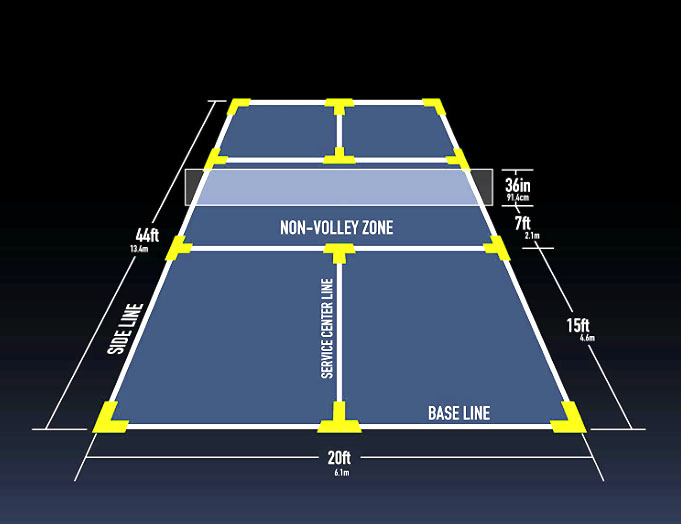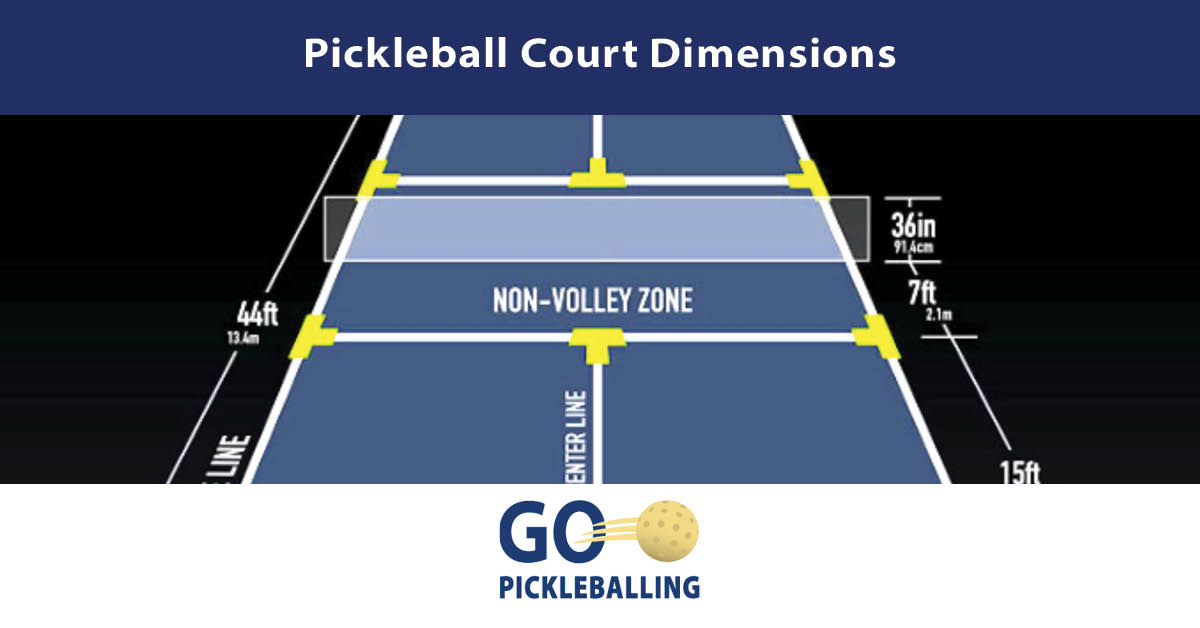If you’re looking to set up a pickleball court in your backyard or maybe the park, the first thing you need to consider are the pickleball court dimensions. The question we get asked all the time is how big is a pickleball court? The easy answer is a pickleball court is a little smaller than a tennis court so you will need lots of room when thinking about playing space.
Standard Pickleball Court Layouts
Pickleball courts are typically 20 feet wide by 44 feet long, but can be adjusted to fit the size of your playing area. The court should be marked with pickleball court marketing lines and the net hight at 36 inches high in the middle and 34 inches high at the posts. The kitchen or non volley zone is located 7 feet from the net marked with a parallel line on each side, and a doubles court should leave a minimum of 15 feet of space behind the kitchen. The court should also have two baselines that are located at the far ends of the court.

How Big Should the Out of Bounds area Around the Pickleball Court Be?
When playing pickleball, there are guidelines for how big the out-of-bounds areas should be. The rulebook says the minimum playing area should be 30 feet by 60 feet, but it’s even better to have a 10-foot margin around the court, making it 40 feet by 64 feet. This extra space gives players more room to stay safe when the ball goes out of bounds, but it’s not always required.
Sometimes, players have to play on tennis courts or in gyms where the space is already set. In those cases, it’s essential to have enough margin space, especially if there are multiple games happening side by side. You wouldn’t want players accidentally running into each other.
If the courts are too close together, balls from one court might end up in the other when they go out of bounds. The rulebook also has other suggested playing surface dimensions for different situations.
10 Areas of a Pickleball Court
-
Dimensions: The pickleball court is a rectangular area that measures 20 feet wide by 44 feet long. It is divided into different sections to accommodate various aspects of the game.
-
Baseline: The baseline is the back boundary of the court. Players serve from behind the baseline and must stay behind it until the ball is in play.
-
Centerline: The centerline runs horizontally across the court, dividing it into two equal halves. It is used for positioning during serve and doubles play.
-
Non-Volley Zone (NVZ): Also referred to as the “kitchen,” the NVZ is a 7-foot area located on both sides of the net. Players cannot enter this zone to volley the ball unless it has bounced. This zone helps prevent overly aggressive play near the net.
-
Service Areas: The service areas are the two sections on opposite sides of the net where players serve the ball. They extend 10 feet from the net to the baseline and are divided by the centerline.
-
Sidelines: The sidelines are the two boundary lines running along the length of the court, on both sides. The ball must land within these lines during play to be considered in-bounds.
-
Baseline Extension: The baseline extension is an additional 7-foot section beyond the baseline. It is not always present on all pickleball courts but is commonly used for tournament play to allow players more space for deep shots.
-
Net: The net divides the court into two halves vertically. Pickleball net height of 36 inches tall at the sidelines and 34 inches tall in the center. The net should be taut and positioned at a height that allows the ball to pass underneath during play. Learn more about Official Pickleball Net Height.
-
Service Boxes: The service boxes are two smaller rectangular areas within the service areas. Players must serve diagonally into the opponent’s service box, and the ball must land within these boxes to be considered a legal serve.
-
Transition Area: The transition area refers to the space between the non-volley zone and the baseline. It is a strategic zone where players position themselves to respond to shots and move from defense to offense or vice versa.
Pickleball Court Surface Materials
There are two main types of pickleball surfaces to chose from. The most popular surface material for pickleball courts is acrylic. Acrylic is a type of paint that is applied to concrete or asphalt surfaces. It is a cost-effective option that can be easily installed and maintained. Acrylic surfaces provide a consistent playing surface with good ball bounce, and they come in a variety of colors to match the aesthetic of your facility or community.
The second option is a poured-in-place rubber surface. These surfaces are made of rubber granules mixed with a binder and poured onto a concrete or asphalt base. This surface is very durable, low maintenance and provides a consistent playing surface with good ball bounce. Additionally, it’s also a very safe option for players, as it provides a softer surface to fall on as compared to concrete or asphalt.
Pickleball Court Markers
When playing pickleball outside court markers are used to outline the boundaries of the court, identify key points, and help players understand the rules of the game. Pickleball court markers come in a variety of shapes and sizes, including circles, rectangles, triangles, and even custom shapes. The most common shapes are the circle and rectangle, which are used to identify different parts of the court and help players stay within the boundaries.
Pickleball court markers are usually made from either metal or plastic, depending on the type of court and the budget available. Metal markers are typically more expensive than their plastic counterparts, but they are also more durable and long lasting. Plastic court markers are cheaper and easier to install, but they are also more prone to damage and may need to be replaced more often.
Building a Pickleball Court in your Backyard
In addition to the pickleball court dimensions, there are a few other factors to consider when building a court in your backyard. The surface of the court should be level and smooth, and should be made of asphalt, concrete, or a sport court surface. The court should also be enclosed with a fence or net, and the net should be hung at a height of 36”.
Now that you’re familiar with how big a pickleball court is and court dimensions, you’re ready to start building or laying out your court. With a few modifications to the size and layout, you can create a court that is perfect for your backyard. Whether you’re looking for a court for doubles or singles, a little bit of planning and preparation can go a long way in creating the perfect pickleball court.







